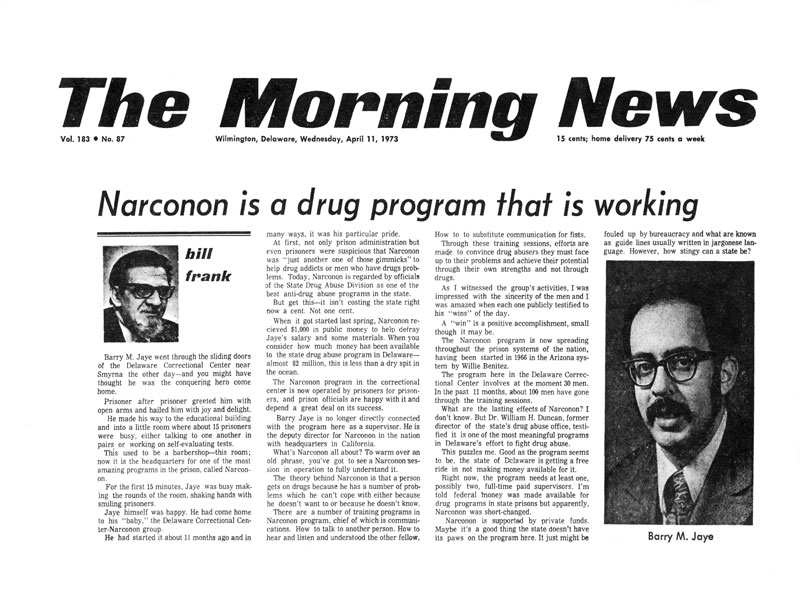Narconon is a Drug Program That is Working

Barry M. Jaye went through the sliding doors of the Delaware Correctional Center near Smyrna the other day–and you might have thought he was the conquering hero come home.
Prisoner after prisoner greeted him with open arms and hailed him with joy and delight.
He made his way to the educational building and into a little room where about 15 prisoners were busy, either talking to one another in pairs or working on self-evaluating tests.
This used to be a barbershop–this room; now it is the headquarters for one of the most amazing programs in the prison, called Narconon.
For the first 15 minutes, Jaye was busy making the rounds of the room, shaking hands with smiling prisoners.
Jaye himself was happy. He had come home to his “baby,” the Delaware Correctional Center Narconon group.
He had started it about 11 months ago and in many ways, it was his particular pride.
At first, not only prison administration but even prisoners were suspicious that Narconon was “just another one of those gimmicks” to help drug addicts or men who have drugs problems. Today, Narconon is regarded by officials of the State Drug Abuse Division as one of the best anti-drug abuse programs in the state.
But get this–it isn’t costing the state right now a cent. Not one cent.
When it got started last spring, Narconon received $1,000 in public money to help defray Jaye’s salary and some materials. When you consider how much money has been available to the state drug abuse program in Delaware almost $2 million, this is less than a dry spit in the ocean.
The Narconon program in the correctional center is now operated by prisoners for prisoners, and prison officials are happy with it and depend a great deal on its success.
Barry Jaye is no longer directly connected with the program here as a supervisor. He is the deputy director for Narconon in the nation with headquarters in California.
What’s Narconon all about? To warm over an old phrase, you’ve got to see a Narconon session in operation to fully understand it.
The theory behind Narconon is that a person gets on drugs because he has a number of problems which he can’t cope with either because he doesn’t want to or because he doesn’t know.
There are a number of training programs in Narconon program, chief of which is communications. How to talk to another person. How to hear and listen and understood the other fellow. How to substitute communication for fists.
Through these training sessions, efforts are made to convince drug abusers they must face up to their problems and achieve their potential through their own strengths and not through drugs.
As I witnessed the group’s activities, I was impressed with the sincerity of the men and I was amazed when each one publicly testified to his “wins” of the day.
A “win” is a positive accomplishment, small though it may be.
The Narconon program is now spreading throughout the prison systems of the nation, having been started in 1966 in the Arizona system by Willie Benitez.
The program here in the Delaware Correctional Center involves at the moment 30 men. In the past 11 months, about 100 men have gone through the training sessions.
What are the lasting effects of Narconon? I don’t know. But Dr. William H. Duncan, former director of the state’s drug abuse office, testified it is one of the most meaningful programs in Delaware’s effort to fight drug abuse.
This puzzles me. Good as the program seems to be, the state of Delaware is getting a free ride in not making money available for it.
Right now, the program needs at least one; possibly two, full-time paid supervisors. I’m told federal money was made available for drug programs in state prisons but apparently, Narconon was short-changed.
Narconon is supported by private funds. Maybe it’s a good thing the state doesn’t have its paws on the program here. It just might be fouled up by bureaucracy and what are known as guide lines usually written in jargonese language. However, how stingy can a state be?
By Bill Frank